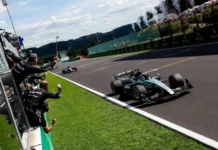With NASCAR officials focusing on engine changes in the Sprint Cup Series for 2015 that will result in a reduction of horsepower, such a move should involve “a restriction on the intake side,” according to Sprint Cup Series team co-owner Jack Roush.
Roush, an owner in the series since 1988, isn’t suggesting the use of restrictor plates similar to those used at Daytona and Talladega.
Instead, he said, a reduction of the throttle bore size “without a plate underneath” would accomplish the objective.
“(It is) straightforward and it is easily reversible if you decided that the quality of the racing was hurt by it,” Roush told NASCAR.com during the Sprint Cup Series stop at Darlington Raceway on April 12.
“If they want to take 100 horsepower off … reduce horsepower significantly, the least expensive and most palatable way to do that is with a restriction on the intake side.”
Earlier this month, NASCAR Chairman and CEO Brian France told Sirius XM NASCAR Radio that changes to the current engine packages used in the Cup Series are coming, perhaps as soon as next season.
France said such a move would be “part of the overall rules packages that we design that hopefully control costs, hopefully make the racing better.”
Today’s Cup engines, limited to 358 cubic inches, produce approximately 850 horsepower. Speeds have increased, in part due to a new rules package and the continued development of the Generation-6 car, now in its second year.
While officials with the three auto manufacturers currently involved at the series’ top level, Chevrolet, Ford and Toyota, have been a part of the discussions, they say it is too early in the process to respond to potential engine changes.
Roush, who turns 72 on April 19, is the co-owner of Roush Fenway Racing. The organization has won the NASCAR Cup title twice – with former drivers Matt Kenseth in 2003 and Kurt Busch in ’04. The organization’s 134 victories rank Roush Fenway fourth highest overall and No. 3 among current teams in the series.
He is also co-owner of Roush Yates Engines, which supplies engines to more than one dozen Sprint Cup Series teams.
“From an owner’s standpoint, NASCAR has got to be mindful of … what it costs,” Roush said. “The race teams can only afford to change so many things at a time. With the expanding technology and the engineering costs that everybody has with the pressure for sponsorship and investment in the sport, a dramatic or unnecessary engine change would not be welcome in my world.”
Roush said previous conversations with NASCAR officials have focused on two considerations.
“One of them is not a big-cost problem and the other one is,” he said. “If NASCAR comes back and redefines the engine right away, says we’re going to a 4-valve, twin overhead cam package, that would be a death knell for a lot of teams in terms of what it would cost to re-power these things.
“I don’t think it would materially impact the competitiveness of the cars, or the quality of the product that the consumers buy either from watching it on TV or from buying a seat in the stands.
“The thing that NASCAR has talked about, that they’ve brought to my attention, is changing the displacement of the engine in an effort to reduce 100 horsepower; that gets thumbs down from me because the cost of crankshafts, and the obsolescence that are involved and the development that follows that are going to cost the teams millions of dollars.
“I think NASCAR has asked ‘what about that?’ but I don’t think they are serious in wanting to push that.”
Roush said it appears more likely that the change will involve lowering the engine RPM, “which would be less hard on the engine,” and could include “a requirement that you use the engine for two races.
“I think that’s more likely where they will wind up,” he said.
Both the Nationwide and Camping World Truck Series currently operate with a “sealed engine” program.
Such a move at the Cup level would mean higher initial costs due to development and construction, but by making the engine last for two races a net savings could be realized.
“By reducing the RPM, you reduce the power available for the car without changing its restriction or changing its displacement,” said Roush. “By making the requirement that an engine be run twice before it was subject to rebuild, we would have that opportunity to reduce costs to the teams.”
Roush said there is also talk of moving away from flat tappet camshafts in Cup engines to a roller camshaft similar to what is currently used in the Nationwide and Truck series.
“Right now you have to search the world for the best steel and best coating process to be able to have the friction characteristics that will allow you to run a flat tappet camshaft competitively,” he said.
“The roller camshaft lifter arrangement will be much easier to source from a component point of view and much easier for the marginal teams to be able to get camshafts in their engines that will be durable.”

















































